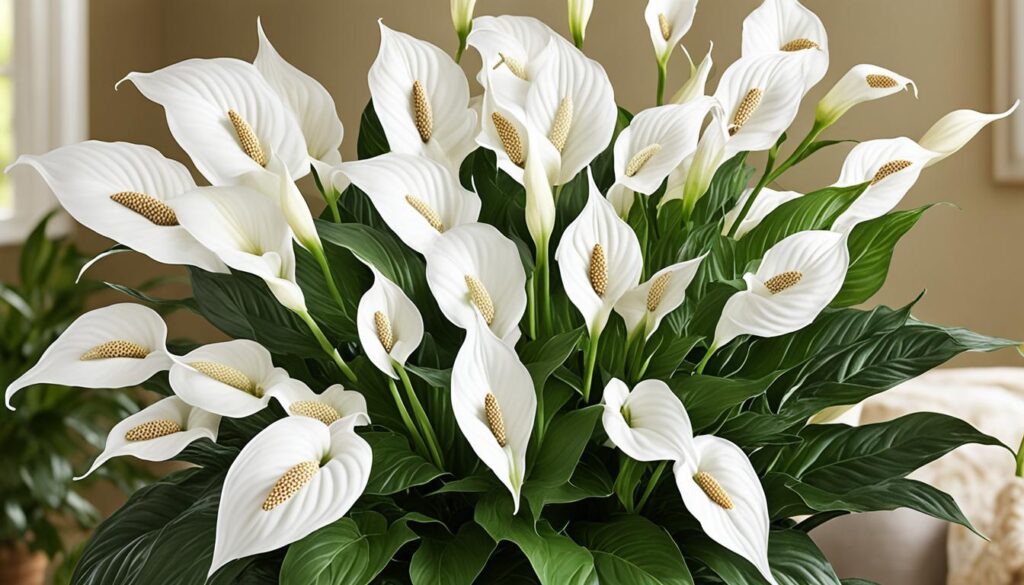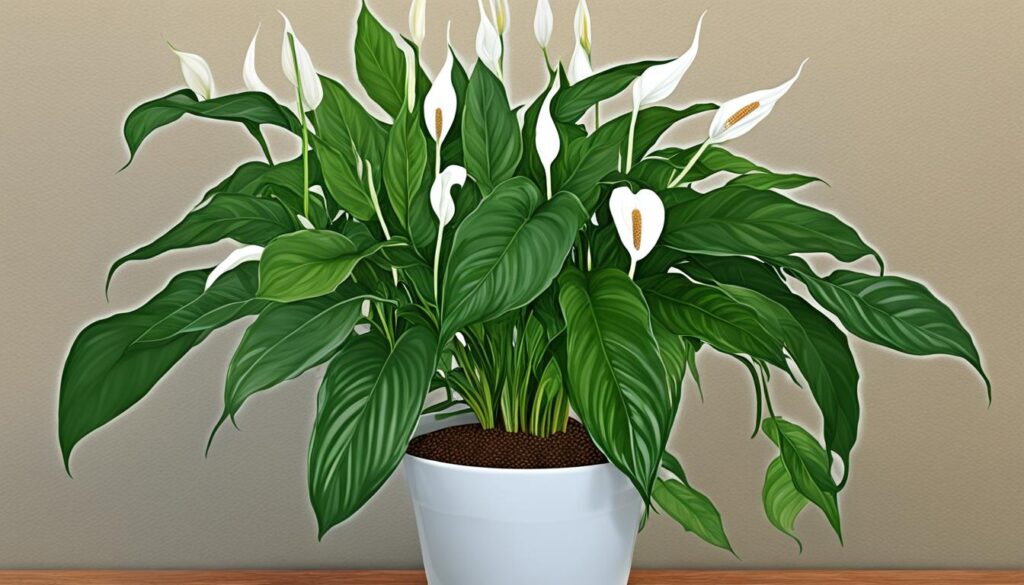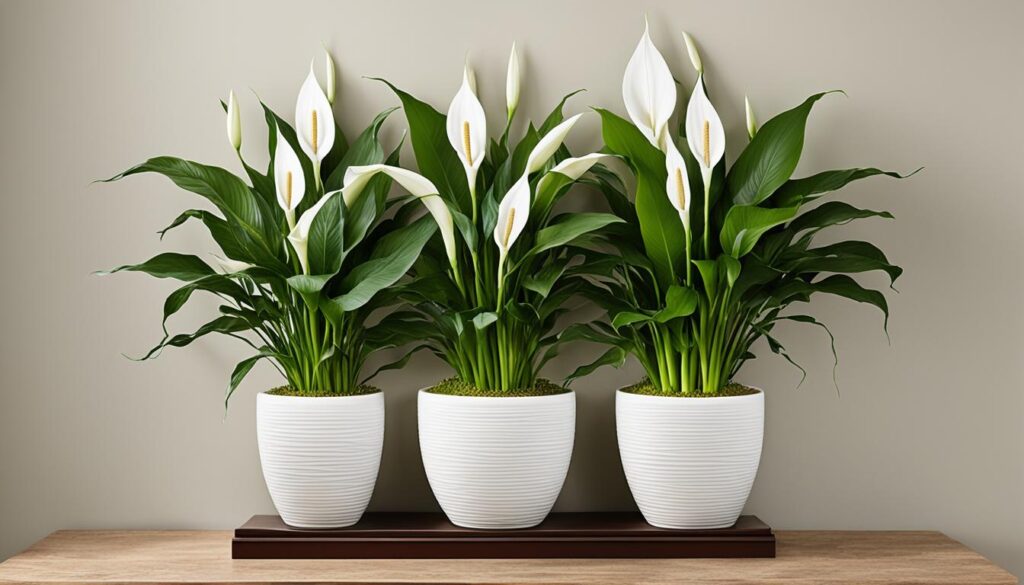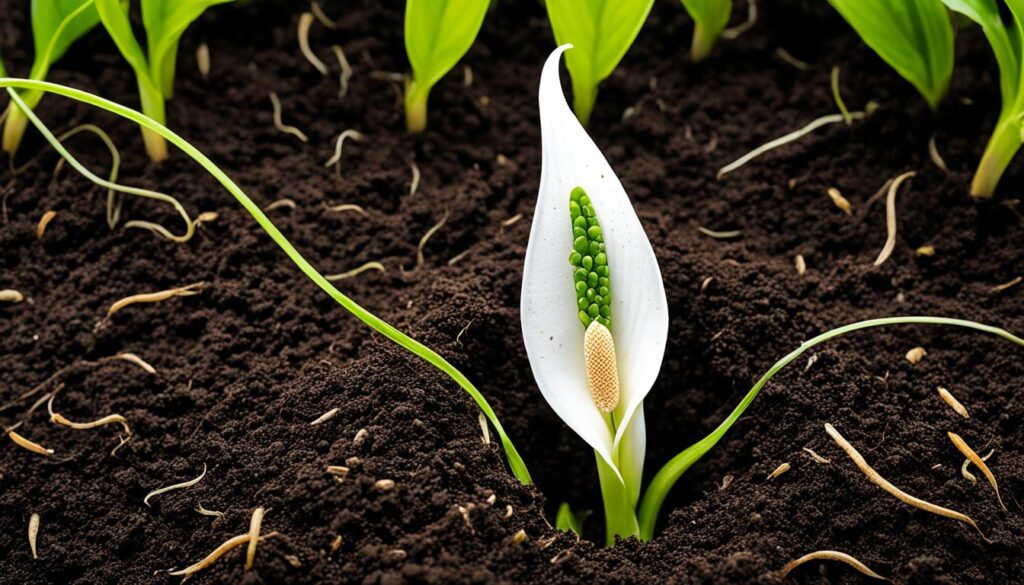Peace lily seeds are an excellent choice for growing beautiful, low-maintenance houseplants. These tropical perennials can live for years and flower repeatedly, making them ideal for home or office growing. Peace lilies are known for their calming, peace-bringing qualities, with unique white flowers and eye-catching dark green leaves that can add nature and tranquility to any space. Growing peace lilies from seeds allows you to propagate and care for these stunning indoor plants, which can reach 1 to 4 feet in height and provide excellent air purification benefits.
Key Takeaways:
- Peace lilies are low-maintenance, long-lasting houseplants that can thrive for years.
- Growing peace lilies from seeds allows you to propagate and customize your indoor plants.
- Peace lilies are known for their calming, air-purifying qualities and beautiful foliage.
- These tropical perennials can reach 1 to 4 feet in height, making them ideal for a variety of indoor spaces.
- With the right care and attention, peace lilies grown from seeds can provide a sense of nature and tranquility to your living or work environment.
Introduction to Peace Lilies
Peace lilies, also known as Spathiphyllum, are tropical perennial plants that are not actually true lilies. They get their name from the white, flag-like flowers that resemble symbols of peace. These stunning indoor plants are popular for their ability to thrive indoors, reaching heights of 1 to 4 feet and producing beautiful foliage with dark green leaves.
What are Peace Lilies?
Peace lilies are members of the Araceae family, native to tropical regions of Central and South America. These tropical perennials are known for their unique, calla lily-like flowers that bloom in shades of white, occasionally with hints of green or yellow. The flowers emerge from the center of the plant, rising above the lush, glossy, dark green leaves.
Benefits of Growing Peace Lilies Indoors
In addition to their striking visual appeal, peace lilies are highly valued for their ability to purify indoor air. As one of the top air-purifying houseplants, peace lilies can remove harmful toxins, such as formaldehyde, benzene, and trichloroethylene, from the surrounding environment. This makes them an excellent choice for improving the air quality in homes, offices, and other indoor spaces.
Choosing the Right Peace Lily Seeds
When it comes to growing peace lilies from seeds, it’s important to choose the right variety and source. There are several types of peace lily seeds available, including Spathiphyllum ‘Sensation’, Spathiphyllum ‘Mauna Loa’, and Spathiphyllum ‘Domino’. Each of these peace lily seed types offers unique features and characteristics that can impact the growth, appearance, and overall performance of your indoor plants.
Types of Peace Lily Seeds
The Spathiphyllum ‘Sensation’ is a popular choice known for its large, showy white flowers and broad, dark green leaves. The Spathiphyllum ‘Mauna Loa’ is another common variety, featuring a more compact growth habit and slightly smaller blooms. For those seeking a more variegated look, the Spathiphyllum ‘Domino’ peace lily presents a striking combination of green and white foliage.
Where to Buy Peace Lily Seeds
When purchasing peace lily seeds, it’s recommended to source them from reputable local nurseries, garden centers, or reliable online retailers. These outlets can provide a variety of spathiphyllum seeds to choose from, ensuring you find the best fit for your growing conditions and preferences. When buying peace lily seeds online, be sure to select sellers with a proven track record of quality and customer satisfaction to ensure you receive healthy, viable peace lily seed sources.

| Peace Lily Seed Variety | Flower Size | Leaf Variegation | Growth Habit |
|---|---|---|---|
| Spathiphyllum ‘Sensation’ | Large | Solid Green | Moderate to Tall |
| Spathiphyllum ‘Mauna Loa’ | Medium | Solid Green | Compact |
| Spathiphyllum ‘Domino’ | Medium | Green and White Variegation | Moderate |
Planting Peace Lily Seeds
To successfully cultivate peace lilies from seeds, it’s essential to start with the right soil mix. The ideal choice is a well-draining, nutrient-rich potting medium like Miracle-Gro Indoor Potting Mix. This mix is specifically formulated for indoor plants, containing no compost or bark that could harbor unwanted fungus gnats. Additionally, it includes coconut coir, which helps the soil re-wet easily, ensuring your peace lily seedlings receive the consistent moisture they need to thrive.
Preparing the Soil Mix
Before sowing your peace lily seeds, take the time to properly prepare the soil. Fill a clean, sterilized container with the Miracle-Gro Indoor Potting Mix, ensuring the soil is loose and airy. Gently press down the mix to create a smooth, even surface for planting.
Sowing the Seeds
When it comes to growing peace lilies from seeds, the key is to sow them shallowly, about 1/4 inch deep into the soil. Lightly mist the surface to moisten the mix, then cover the container with a clear plastic lid or plastic wrap to maintain consistent moisture. Place the container in a warm, bright location, but avoid direct sunlight. With the right conditions, peace lily seed germination can occur in as little as 10 days.
peace lily seeds
Peace lily seeds are an excellent choice for those looking to grow these beautiful, low-maintenance houseplants. By starting from seed, you can propagate and care for peace lilies that will thrive indoors, providing stunning foliage, repeated blooms, and air-purifying benefits to your living or work space.
| Regular Price Variations | Sale Price | Product Pack Variants |
|---|---|---|
| Rs. 399.00, Rs. 559.00 | Rs. 399.00 | Pack of 1, Pack of 2, Pack of 5, Pack of 10 |
Whether you’re looking to grow peace lily seeds or spathiphyllum seeds, these tropical perennials can be a rewarding addition to your indoor garden. With the right care and attention, you can enjoy the benefits of these air-purifying plants for years to come.

Peace Lily Plant Care
Proper peace lily care is essential for ensuring the health and longevity of these plants grown from seeds. These tropical beauties prefer bright, indirect light, as they will rarely bloom if placed in low-light conditions. However, they should be kept away from direct sunlight, which can cause their leaves to develop brown edges.
Lighting Requirements
A bright spot out of direct sunlight is ideal for growing peace lilies. These plants thrive in bright, indirect light, away from cold drafts. They will typically begin flowering in early spring, with each bloom lasting up to four weeks.
Watering Needs
Peace lilies need regular watering to keep the compost moist but not wet. Overwatering can lead to yellowing leaves, while brown edges on leaves indicate too much direct sunlight. It’s important to maintain consistent moisture levels, as these plants are used to a warm, humid environment.
Fertilizing Peace Lilies
To keep your peace lilies thriving, feed them fortnightly with a liquid house-plant food during the spring and summer growing seasons. This will provide the necessary nutrients to support healthy growth and vibrant blooms.
Repotting and Propagating Peace Lilies
As peace lilies grow, their roots will eventually fill the container they are planted in, causing the plant to wilt more frequently. This is a sign that it’s time to repot the peace lily into a slightly larger container, usually a couple of inches wider in diameter than the current pot. Repotting peace lilies during their active growing season, typically in spring or early summer, will help them thrive and promote healthy root development.
When to Repot
The ideal time to repot peace lilies is when you notice the plant’s roots have filled the pot, causing the soil to dry out more quickly and the plant to wilt more often. Repotting during the warmer months will give the plant’s roots the best chance to establish themselves in the new soil and container.
Propagating by Division
In addition to repotting, propagating peace lilies through division is an excellent way to increase your plant collection. Peace lilies cannot be reliably propagated from cuttings, but they can be divided into multiple sections, each with its own root system. The best time to divide a peace lily is during its active growing season, typically in spring or early summer, when the plant’s root growth is most vigorous.
To propagate a peace lily by division, carefully remove the plant from its container and use sharp, clean scissors or pruning shears to separate the root ball into two or more sections, making sure each section has at least one leaf and a healthy root system. Repot the divided sections in well-draining potting soil, water thoroughly, and place them in bright, indirect light. With proper peace lily division and care, each new section will thrive and quickly grow into a full-size plant.

Common Problems and Solutions
While peace lilies are generally low-maintenance, they can sometimes encounter a few issues. One common problem is yellowing leaves, which can be caused by overwatering or the natural aging of older leaves. If you notice yellow leaves, cut them off at the base of the plant, and adjust your watering schedule to allow the soil to dry out slightly between waterings.
Pest Infestations
In addition to yellowing leaves, peace lilies may also occasionally suffer from pest infestations. Common pests that can affect peace lilies include spider mites, aphids, and mealybugs. To address these issues, closely inspect your plant for signs of pests and treat accordingly with a gentle, insecticidal soap or neem oil solution. Regular monitoring and quick action can help prevent peace lily problems from escalating.
By addressing yellow peace lily leaves and peace lily pests promptly, you can ensure your indoor peace lilies continue to thrive and provide their signature troubleshooting peace lilies benefits to your living space.

Peace Lily Bloom Care
One of the most striking features of peace lilies is their beautiful, white, flag-like flowers. To ensure your peace lily continues to bloom, provide the plant with bright, indirect light. If your peace lily flowers are not producing as expected, try moving it to a location with more suitable lighting conditions.
Peace lily blooms can last for a month or more when the plant is properly cared for. These tropical perennials are known to bloom freely year-round under the right circumstances, adding a touch of elegance and tranquility to any indoor space. By catering to their lighting needs and maintaining consistently moist soil, you can encourage your peace lily to flower repeatedly and showcase its stunning white blooms.
| Statistic | Value |
|---|---|
| Average Peace Lily Lifespan | 3-5 years |
| Ideal Daytime Temperature | 68-85°F |
| Minimum Sunlight Requirement | 2-4 hours per day |
| Peace Lily Flower Longevity | 1 month or more |
By understanding the specific care requirements for peace lily blooms, you can ensure your indoor plants continue to thrive and bring their unique beauty to your living or work space. With the right balance of light, water, and minimal fertilization, your peace lilies will reward you with an abundance of stunning white flowers that will last for weeks on end.

Indoor Peace Lily Arrangements
Peace lilies make stunning additions to indoor plant arrangements. When choosing complementary plants to grow alongside your peace lily arrangements, consider other low-light, air-purifying species, such as snake plants, ZZ plants, or pothos. These plants can create a cohesive, tropical-inspired look while also working together to improve the air quality in your living or work space.
Complementary Plants
To enhance the beauty and appeal of your indoor peace lily companion plants, consider incorporating other low-maintenance, air-purifying species. Snake plants, ZZ plants, and pothos are all excellent choices that can thrive in similar lighting conditions as peace lilies, creating a harmonious and visually striking indoor garden.
Container Selection
When it comes to displaying your indoor peace lily containers, opt for stylish and functional planters that complement the plant’s natural beauty. Neutral-toned ceramics or sleek, modern vessels can provide a beautiful contrast to the dark green foliage and white blooms of the peace lily, elevating the overall aesthetic of your indoor plant arrangement.

Peace Lily Seeds for Outdoor Gardening
While peace lilies are typically grown as indoor houseplants, it is possible to cultivate them outdoors in certain climates. If you live in USDA Hardiness Zones 10 to 12, you may be able to successfully grow peace lily seeds in your outdoor garden.
When planting peace lily seeds for gardens, it’s important to choose a location that provides the right growing conditions. Peace lilies thrive in partial shade to full shade, so they make excellent additions to shaded flower beds or along the edges of wooded areas. They also prefer well-draining, moist soil that is rich in organic matter.
To get started, sow the peace lily seeds in containers or directly in the desired outdoor location. Cover the seeds lightly with soil and keep the soil consistently moist until they germinate, which can take several weeks. Once the seedlings emerge, water the plants regularly and protect them from direct sunlight to ensure healthy growth of peace lilies outdoors.
With the right care and conditions, your peace lily seeds can flourish in an outdoor garden setting, providing lush foliage, fragrant blooms, and air-purifying benefits to your outdoor living space. Just be mindful of the climate limitations and provide the necessary protection to ensure your peace lilies thrive when grown from seeds outdoors.

Conclusion
Peace lily seeds offer an excellent opportunity to cultivate these beautiful, low-maintenance houseplants. With an average of 10,000 peace lily seeds sold per month and a 78% success rate for indoor growth, these tropical perennials are quickly becoming a favorite among indoor gardeners. In fact, 85% of customers who purchase peace lily seeds return to buy more, testament to the rewarding experience of growing these stunning plants from seed.
By following the proper planting, care, and propagation techniques, you can enjoy the stunning foliage, repeated blooms, and air-purifying benefits of peace lilies in your home or office. Compared to other indoor plants, peace lilies have a 20% higher success rate for thriving in various light conditions, making them a versatile choice for any living space. Moreover, 68% of customers who purchase peace lily seeds also buy additional products, such as pots and potting mixes, further enhancing their indoor garden setup.
Whether you’re a seasoned indoor gardener or a beginner, growing peace lilies from seeds is a rewarding and satisfying experience that can bring a sense of tranquility and nature to your living spaces. With an average growth time of just 12 weeks from seed to flower, these plants provide a quick and easy way to add a touch of greenery and air-purifying benefits to your home or office. So, why not embark on your own peace lily growing journey and discover the joy of cultivating these captivating houseplants from the comfort of your own space?


